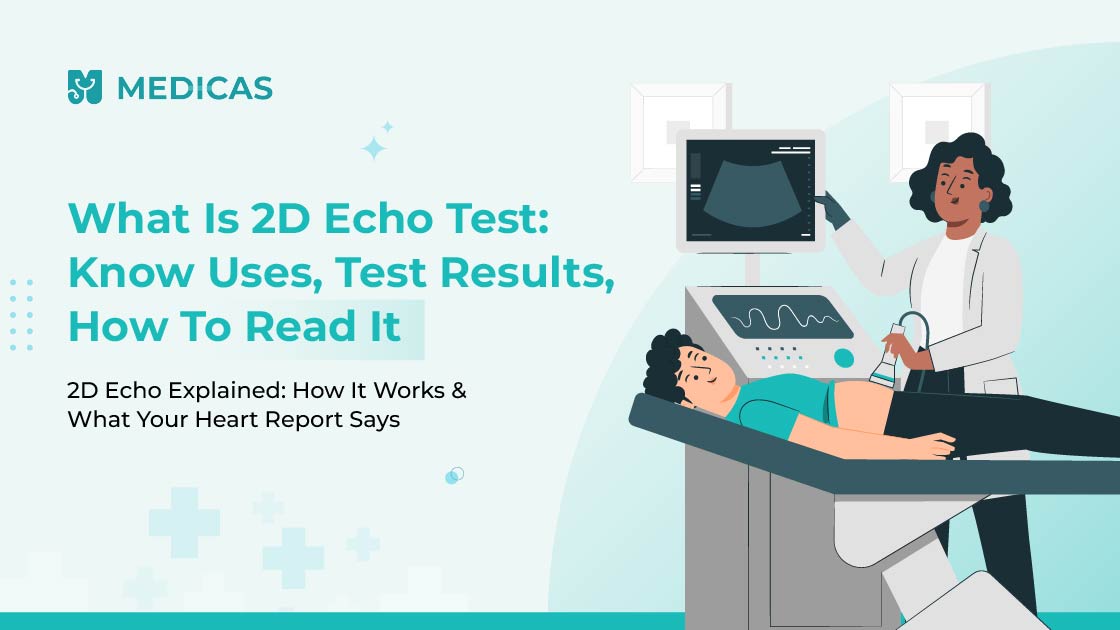Heart health is one of the most crucial aspects of your well-being. If your doctor has suggested a 2D echo test or you’re curious about this heart imaging procedure, understanding what it involves can ease your concerns.
Let’s explore everything you need to know about the 2D echocardiogram — from its procedure and uses to interpreting its results.
1. Understanding the 2D Echo Test
What Is a 2D Echo Test?
A 2D echo test, or a 2D echocardiogram, is a non-invasive imaging test that uses sound waves to create detailed images of your heart. It helps doctors evaluate the heart’s chambers, valves, and blood flow.
In simpler terms, the 2D echo test involves creating a live video of your heart, which helps doctors detect abnormalities and monitor your heart health.
Why Is an Echo Test Done?
Doctors recommend an echo checkup for various reasons, including:
- Evaluate overall heart health
- Detect heart valve issues
- Assess heart muscle strength
- Identify fluid around the heart
- Diagnose congenital heart defects
- Monitor the effectiveness of ongoing heart treatments
2D Echo Test vs. Other Heart Tests
| Aspect | 2D Echo Test | ECG | Stress Test | Angiography |
| Purpose | Visualizes heart structure and function | Records heart’s electrical activity | Evaluates heart response to stress | Detects blockages in coronary arteries |
| Procedure | Ultrasound imaging | Electrodes on chest | Exercise or medication | Dye and X-ray imaging |
| Time Taken | 20-40 minutes | 5-10 minutes | 30-60 minutes | 1-2 hours |
| Invasiveness | Non-invasive | Non-invasive | Non-invasive | Invasive |
| Preparation | Minimal | None | May need fasting | Fasting required |
| Results | Real-time heart images | Heart rhythm graph | Heart response analysis | Artery images |
| Best For | Heart size and valve issues | Arrhythmia detection | Coronary artery disease | Severe blockage diagnosis |
2. 2D Echo Test Procedure & How It Works
2D Echo Test Procedure: Step-by-Step
Here’s what generally happens during a 2D echo procedure:
- Preparation: No special preparation is required for a standard studio test, but you may be asked to wear a hospital gown.
- Electrode Placement: A 2D echo test uses electrodes on your chest to monitor heart activity.
- Gel Application: A gel is applied to the chest to ensure sound waves pass smoothly.
- Image Capture: A handheld transducer sends sound waves, creating images on the monitor.
- Observation: The doctor analyzes the images in real-time.
What to Expect During a 2D Echo Scan
You might feel slight pressure during the scan as the technician moves the transducer over your chest. The procedure is painless and does not involve aadiation. You can relax and even chat with the technician if you wish. The main goal is to capture clear images of your heart to help idiagnoseany issues.
How Long Does a 2D Echo Take?
Typically, a 2D Echo Test takes 30 to 60 minutes, depending on the complexity of your case and the number of images needed. This makes it a quick and efficient way to assess heart function without causing significant disruption to your daily routine.
3. Uses of a 2D Echo Test
2D Echo for Heart Health Monitoring
Doctors often use a 2D Echo to monitor your heart health, especially if you have:
- A history of heart disease
- High blood pressure
- Valve disorders
- Chest pain or breathlessness
Can a 2D Echo Detect Heart Blockage?
While a 2D echocardiography cannot directly detect blockages in coronary arteries, it can identify signs of heart strain or damage caused by blockages, prompting further tests like an angiogram.
4. Reading and Understanding 2D Echo Test Results
What Is a Normal 2D Echo Report?
A 2D Echo normal report typically includes:
- Normal heart chamber size
- Proper valve function
- No abnormal fluid around the heart
- Normal blood flow with no signs of clots or leaks
2D Echo Test Report: Key Indicators
When you receive your echo test report, pay attention to the following key indicators:
- Ejection Fraction (EF): Percentage of blood the heart pumps out with each beat (Normal: 50-70%).
- Heart Wall Motion: Evaluates how well your heart muscles contract.
- Valve Function: Checks for valve narrowing or leakage.
- Heart Chamber Size: Checks for enlargement or thickening.
Interpreting Echo Test Results for Heart Function
If your reports are abnormal, your doctor will explain what that means for your heart health. For instance, a lower-than-normal ejection fraction might suggest heart failure, while abnormal wall motion could indicate past heart damage. Always discuss your results with your healthcare provider to understand the implications and any necessary next steps.
5. 2D Echo Test Cost and Availability
How Much Does a 2D Echo Test Cost?
The cost of a 2D Echo Test in India typically ranges from ₹1500 to ₹4000, depending on the hospital and city.
Where to Get a 2D Echo Test Done?
You can get a 2D Echo at:
- Hospitals
- Diagnostic centres
- Cardiology clinics
Booking an Online Medical Appointment for a 2D Echo Test
Need a 2D Echo test? Medicas makes it easy for you:
- Book lab tests online from the comfort of your home.
- Schedule a consultation through online doctor consultation.
- Book an appointment with a cardiologist for further evaluation.
Conclusion
A 2D Echo Test is a valuable diagnostic tool for assessing heart health. Whether you’re experiencing symptoms, need routine monitoring, or need guidance on home remedies, this test provides detailed insights into your heart’s function.
If you notice any signs of heart trouble, don’t delay. Consult a doctor online, book your 2D Echo, and get timely medical advice. Your heart health matters!
Frequently Asked Questions
Can I get a 2D Echo test done at home?
No, a 2D Echo test requires specialized equipment and must be performed at a diagnostic center or hospital.
Where can I book an online medical appointment for a 2D Echo test?
You can use the book appointment service on Medicas for hassle-free scheduling.
How soon can I get my 2D Echo test results?
Results are usually available within a few hours or by the next day.
What does an abnormal 2D Echo report mean?
An abnormal report could indicate heart valve disease, weakened heart muscles, or fluid buildup. Consult a cardiologist for further evaluation.
Related Blogs
Disclaimer
Medical Advice: The information provided in this blog post is for educational purposes only and should not be considered as a substitute for professional medical advice, diagnosis, or treatment. Always consult with a qualified healthcare professional for personalized guidance regarding your specific medical condition.
Accuracy of Information: While we strive to provide accurate and up-to-date information, the field of medicine and viral fevers is constantly evolving. The content in this blog post may not reflect the most current research or medical guidelines. Therefore, it is advisable to cross-check any information provided with reliable sources or consult a healthcare professional.
Individual Variations: The symptoms, causes, treatment options, and preventive measures discussed in this blog post are general in nature and may not apply to everyone. It is important to remember that each individual’s situation is unique, and personalized medical advice should be sought when making healthcare decisions.
External Links: This blog post may contain links to external websites or resources for additional information. However, we do not endorse or have control over the content of these third-party websites. Accessing these links is done at your own risk, and we are not responsible for any consequences or damages that may arise from visiting these external sources.
Results May Vary: The effectiveness of treatment options or preventive measures mentioned in this blog post may vary from person to person. What works for one individual may not work the same way for another. It is essential to consult with a healthcare professional for personalized advice tailored to your specific needs.



